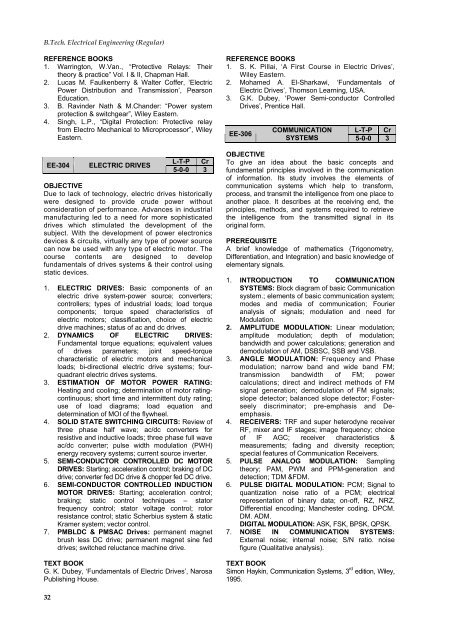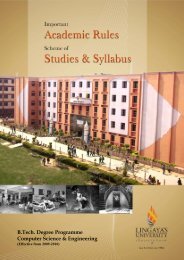B.<strong>Tech</strong>. <strong>Electrical</strong> <strong>Engineering</strong> (Regular)REFERENCE BOOKS1. Warrington, W.Van., “Protective Relays: Theirtheory & practice” Vol. I & II, Chapman Hall.2. Lucas M. Faulkenberry & Walter Coffer, ‘ElectricPower Distribution and Transmission’, PearsonEducation.3. B. Ravinder Nath & M.Chander: “Power systemprotection & switchgear”, Wiley Eastern.4. Singh, L.P., “Digital Protection: Protective relayfrom Electro Mechanical to Microprocessor”, WileyEastern.EE-304ELECTRIC DRIVESL-T-P Cr5-0-0 3OBJECTIVEDue to lack of technology, electric drives historicallywere designed to provide crude power withoutconsideration of performance. Advances in industrialmanufacturing led to a need for more sophisticateddrives which stimulated the development of thesubject. With the development of power electronicsdevices & circuits, virtually any type of power sourcecan now be used with any type of electric motor. Thecourse contents are designed to developfundamentals of drives systems & their control usingstatic devices.1. ELECTRIC DRIVES: Basic components of anelectric drive system-power source; converters;controllers; types of industrial loads; load torquecomponents; torque speed characteristics ofelectric motors; classification, choice of electricdrive machines; status of ac and dc drives.2. DYNAMICS OF ELECTRIC DRIVES:Fundamental torque equations; equivalent valuesof drives parameters; joint speed-torquecharacteristic of electric motors and mechanicalloads; bi-directional electric drive systems; fourquadrantelectric drives systems.3. ESTIMATION OF MOTOR POWER RATING:Heating and cooling; determination of motor ratingcontinuous;short time and intermittent duty rating;use of load diagrams; load equation anddetermination of MOI of the flywheel.4. SOLID STATE SWITCHING CIRCUITS: Review ofthree phase half wave; ac/dc converters forresistive and inductive loads; three phase full waveac/dc converter; pulse width modulation (PWH)energy recovery systems; current source inverter.5. SEMI-CONDUCTOR CONTROLLED DC MOTORDRIVES: Starting; acceleration control; braking of DCdrive; converter fed DC drive & chopper fed DC drive.6. SEMI-CONDUCTOR CONTROLLED INDUCTIONMOTOR DRIVES: Starting; acceleration control;braking; static control techniques – statorfrequency control; stator voltage control; rotorresistance control; static Scherbius system & staticKramer system; vector control.7. PMBLDC & PMSAC Drives: permanent magnetbrush less DC drive; permanent magnet sine feddrives; switched reluctance machine drive.TEXT BOOKG. K. Dubey, ‘Fundamentals of Electric Drives’, NarosaPublishing House.REFERENCE BOOKS1. S. K. Pillai, ‘A First Course in Electric Drives’,Wiley Eastern.2. Mohamed A. El-Sharkawi, ‘Fundamentals ofElectric Drives’, Thomson Learning, USA.3. G.K. Dubey, ‘Power Semi-conductor ControlledDrives’, Prentice Hall.EE-306COMMUNICATION L-T-P CrSYSTEMS 5-0-0 3OBJECTIVETo give an idea about the basic concepts andfundamental principles involved in the communicationof information. Its study involves the elements ofcommunication systems which help to transform,process, and transmit the intelligence from one place toanother place. It describes at the receiving end, theprinciples, methods, and systems required to retrievethe intelligence from the transmitted signal in itsoriginal form.PREREQUISITEA brief knowledge of mathematics (Trigonometry,Differentiation, and Integration) and basic knowledge ofelementary signals.1. INTRODUCTION TO COMMUNICATIONSYSTEMS: Block diagram of basic Communicationsystem.; elements of basic communication system;modes and media of communication; Fourieranalysis of signals; modulation and need forModulation.2. AMPLITUDE MODULATION: Linear modulation;amplitude modulation; depth of modulation;bandwidth and power calculations; generation anddemodulation of AM, DSBSC, SSB and VSB.3. ANGLE MODULATION: Frequency and Phasemodulation; narrow band and wide band FM;transmission bandwidth of FM; powercalculations; direct and indirect methods of FMsignal generation; demodulation of FM signals;slope detector; balanced slope detector; Fosterseelydiscriminator; pre-emphasis and Deemphasis.4. RECEIVERS: TRF and super heterodyne receiverRF, mixer and IF stages; image frequency; choiceof IF AGC; receiver characteristics &measurements; fading and diversity reception;special features of Communication Receivers.5. PULSE ANALOG MODULATION: Samplingtheory; PAM, PWM and PPM-generation anddetection; TDM &FDM.6. PULSE DIGITAL MODULATION: PCM; Signal toquantization noise ratio of a PCM; electricalrepresentation of binary data; on-off, RZ, NRZ,Differential encoding; Manchester coding. DPCM.DM. ADM.DIGITAL MODULATION: ASK, FSK, BPSK, QPSK.7. NOISE IN COMMUNICATION SYSTEMS:External noise; internal noise; S/N ratio. noisefigure (Qualitative analysis).TEXT BOOKSimon Haykin, Communication Systems, 3 rd edition, Wiley,1995.32
Lingaya’s University, FaridabadREFERENCE BOOKS1. Sanjay Sharma, Communication Systems, Kataria& Sons.2. HSU. HWei P, Analog and DigitalCommunications, Schaum's outline series, TataMcGraw Hill, 20033. Singh, R.P. and Sapre, S.D., CommunicationSystems, Analog and Digital, Tata McGraw Hill,2002.4. P Chakraborthy, Analog communication systems,Dhanapati rai & Sons, 20085. Sam Shanmugam.K.; Digital and AnalogCommunication Systems, Wiley, 1998.6. Taub and Shilling, Principles of CommunicationSystems, 2 nd edition, Tata McGraw Hill, 2003.7. Carlson, A.B.; Rutledze.J. and Crilly. P.,Communication Systems, 4 th edition,Tata McGrawHill, 2002.EE-352POWER SYSTEM L-T-P CrENGINEERING – II LAB 0-0-2 1LIST OF EXPERIMENTS1. Symmetrical fault level measurement on a D.CNetwork analyzer.2. Unsymmetrical fault level measurement on a D.CNetwork analyzer for various types of faults.3. To find ABCD parameters of a model oftransmission line.4. To draw the operating characteristics of IDMT relay.5. To observe the Ferranti effect in a model oftransmission line6. To draw the operating characteristics of differentialrelay.7. Testing of transformer oil.8. To study the voltage distribution in an analoguemodel of a string insulator and to compute thestring efficiency.9. Measurement of earth resistance by Earth tester.10. To study circuit breakers.11. To study Bucholtz relay.12. To study plain impedance relay and plot it’stripping characteristics.EE-354ELECRIC DRIVES LABL-T-P Cr0-0-2 1LIST OF EXPERIMENTS1. Speed control of dc motor using dc chopper.2. Speed control of dc motor using single –phaseconverter.3. Speed control of dc motor using 3-phaseconverter.4. Speed control of dc motor using single –phasedual converter.5. Inverter fed single –phase induction motor drive.6. CSI fed induction motor drive.7. Speed control of single –phase induction motorusing ac regulator.8. Regenerative braking of dc motor using singlephaseconverter.9. Speed control of single- phase induction motorusing cycloconverter.10. Static rotor resistance control method.EE-356COMMUNICATION L-T-P CrSYSTEMS LAB 0-0-2 1LIST OF EXPERIMENTS1. Study of Amplitude Modulation and determinationof Modulation index.2. Study of Frequency Modulation and determinationof Modulation index.3. Study of Phase Modulation.4. Study of Pulse Amplitude Modulation.5. Study of Pulse Width Modulation.6. Study of Pulse Frequency Modulation.7. Study of Pulse Code Modulation.8. Study of frequency Shift Keying.9. Study of ASK and QASK.10. Study of PSK and QPSK.11. Project related to the scope of the course.EE-401PROGRAMMABLE LOGIC L-T-P CrCONTROLLERS & SCADA 5-0-0 3OBJECTIVEThe programmable logic controller represents a keyfactor in industrial automation. Its use permits flexibleadaptation to varying processes as well as rapid faultfinding and error elimination. Today, Industrialenvironment is steered with the latest technologicaladvancements in computers and communication.Programmable Logic Controllers (PLC) basedautomation is its outcome. This subject is useful tounderstand the concept of automation used in industry.1. INTRODUCTION: Programmable Logic Controller;advantages of PLCs Over Relay System; inputoutput Section – Fixed input output, Modular inputoutput, Discrete input output Modules, Analoginput output Modules.2. PROCESSOR UNIT: Processor; Memory types;Guarding against Electro Static Discharge;Peripherals; Memory Organization.3. PROGRAMMING DEVICES: ProgrammingDevices; Dedicated Desktop <strong>Programme</strong>s; HardHeld <strong>Programme</strong>s; Computer <strong>Programme</strong>s4. LADDER DIAGRAM & PLC PROGRAMMING:Ladder Diagram Rules; Writing Diagram; LadderDiagram; Basic Stop / START Circuit; Digital Logicgates; Sequenced Motor Starting; Relay TypeInstruction; Programming a PLC; PLC Peripherals;Network Limitation; Program Scanning5. Program Control Instructions: Master ControlRelay Instructions; Latching Relay instruction;immediate input output instruction; Jump and LabelInstruction.6. PROGRAMMING TIMER & COUNTERS:Pneumatic Timers; Cascading Timers; AllenBradley PLCs Counters; Combining Timer &Counters.7. SCADA: Introduction; Concept of AutomaticScada; Architecture of Scada; Hierarchical ofSupervisory Control & Data Acquisition System;<strong>Tech</strong>nology Available; Data Acquisition Unit;Remote <strong>Tech</strong>nical Unit.TEXT BOOKCox Richard A., “<strong>Tech</strong>nician’s Guide to ProgrammableControllers”, 4 th Ed., Delmar Thomson Learning, 2001.33
- Page 1 and 2: B.Tech. Degree ProgrammeElectrical
- Page 5 and 6: Lingaya’s University, FaridabadAB
- Page 7 and 8: IMPORTANT ACADEMIC RULESB.Tech. Deg
- Page 9 and 10: Lingaya’s University, Faridabadac
- Page 11 and 12: Lingaya’s University, FaridabadSe
- Page 13 and 14: Lingaya’s University, FaridabadIn
- Page 15 and 16: CATEGORY-WISE LIST OF COURSESLingay
- Page 17 and 18: Lingaya’s University, FaridabadSU
- Page 19 and 20: Lingaya’s University, FaridabadSc
- Page 22 and 23: B.Tech. Electrical Engineering (Reg
- Page 24 and 25: B.Tech. Electrical Engineering (Reg
- Page 26 and 27: B.Tech. Electrical Engineering (Reg
- Page 28 and 29: B.Tech. Electrical Engineering (Reg
- Page 30 and 31: B.Tech. Electrical Engineering (Reg
- Page 32 and 33: B.Tech. Electrical Engineering (Reg
- Page 34 and 35: B.Tech. Electrical Engineering (Reg
- Page 38 and 39: B.Tech. Electrical Engineering (Reg
- Page 40 and 41: B.Tech. Electrical Engineering (Reg
- Page 42 and 43: B.Tech. Electrical Engineering (Reg
- Page 44 and 45: B.Tech. Electrical Engineering (Reg
- Page 46 and 47: B.Tech. Electrical Engineering (Reg
- Page 48 and 49: B.Tech. Electrical Engineering (Reg
- Page 50 and 51: B.Tech. Electrical Engineering (Reg
- Page 52 and 53: B.Tech. Electrical Engineering (Reg
- Page 54 and 55: B.Tech. Electrical Engineering (Reg
- Page 56 and 57: B.Tech. Electrical Engineering (Reg
- Page 58 and 59: B.Tech. Electrical Engineering (Reg
- Page 60 and 61: B.Tech. Electrical Engineering (Reg
- Page 62 and 63: B.Tech. Electrical Engineering (Reg
- Page 64 and 65: B.Tech. Electrical Engineering (Reg
- Page 66 and 67: B.Tech. Electrical Engineering (Reg
- Page 68 and 69: B.Tech. Electrical Engineering (Reg
- Page 71 and 72: OPEN ELECTIVELingaya’s University
- Page 73 and 74: Lingaya’s University, Faridabadch
- Page 75 and 76: Lingaya’s University, Faridabad4
- Page 77 and 78: Lingaya’s University, Faridabad6.
- Page 79 and 80: Lingaya’s University, FaridabadEL
- Page 81 and 82: Lingaya’s University, Faridabad5
- Page 83 and 84: Lingaya’s University, Faridabador
- Page 85 and 86: Lingaya’s University, Faridabad4.
- Page 87:
Lingaya’s University, Faridabad83
















